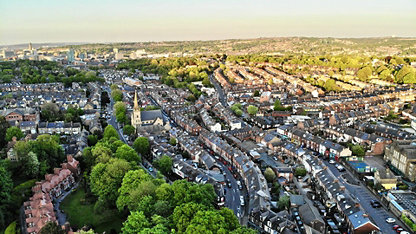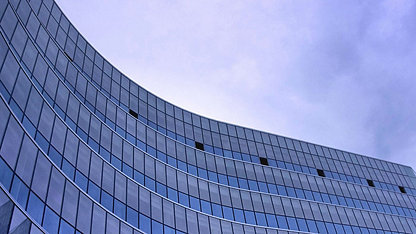Investment in CRE critical to levelling up, and potential impact far outweighs current focus on infrastructure
CRE can support levelling up ‘in place’ creating opportunity and regeneration for communities
- RICS impact report highlights contributions of commercial property - for every £1 spent on the sector, £0.9 can be gained elsewhere
- Government must establish framework to support aims of our UK regions – attracting investors that support economic regeneration and an increase in social value – CRE can support levelling up ‘in place’ rather than moving people to already developed areas
- Report makes asks of sector and Gov to supercharge levelling up, increase wellbeing, create jobs, and hit sustainability targets - Government and industry must partner to ensure success
- 50% of commercial buildings could become stranded assets by 2035 if not retrofitted to meet targets – “decarbonisation and wellbeing cannot be ignored at expense of economic recovery”
RICS today publishes its first RICS Commercial real estate impact report*, outlining the contribution of CRE, and how to ensure that CRE becomes a key driver in levelling up the UK, increasing sustainability and wellbeing, and building communities.
CRE contributes 3.5% of UK employment (1,088,500 people), with every £1m spent on the sector generating employment for 11.2 people. The sum of direct, indirect, and induced Gross Value Add (GVA) (£66.3bn) generated corresponds to 3.3% of the UK total, and for every £1 spent on the sector, £0.9 can be gained elsewhere (GVA generated). It provides significant opportunities for driving inward UK investment, with capital value having nearly doubled since 2000, and in 2020, retail, office and industrial segments accounted for between £260bn and £280bn, with other asset types at around £100bn.
While CRE is facing challenges, it is well placed to adapt, and while infrastructure and moving between cities is often overly focussed on in the quest to level up, commercial property use and evolution can and should be a driving force behind the levelling up agenda, increasing productivity and sparking a boom in placemaking and the creation of communities.
Regional differences for economic development and opportunities are stark, but the report highlights that well-designed and well-managed commercial assets help businesses to flourish, and communities to be built and maintained. High-quality workspaces create employment satisfaction and well-being, and help retain talent. Well thought mixed development in urban infills and brownfields regenerate the local area, generate lower demand for transport and lead to safer environments. Research shows that urban areas with a diverse mix of uses have higher social capital.**
RICS calls on sector and Government to work together, and with other bodies, to drive solutions that do not mean a trade-off between objectives and that utilise the sectors potential.
Key recommendations for Government include:
- Establish a framework that supports regions to attract inward investment – focusing on patient investors willing to finance long-term development with social value creation
- Embed contribution and social value of commercial real estate into the levelling up agenda - providing financial support for the renovation of key assets that risk becoming stranded and cannot afford upfront costs, also upskilling and increasing the construction workforce
- Reform business rates so they include proportionality/connection to ESG performance - there is also no universally adopted set of metrics to measure ESG performance of real estate assets, investors and owners face different reporting creating confusion and the risk of ‘greenwashing’.
- There is clear evidence that the EPC is inadequate to support decarbonisation efforts - review methodology for commercial buildings
In combination with these policy recommendations, this report sets out a series of actions that the sector itself can take – before waiting for Government - including:
- Coordinate with other industry sectors that stand to benefit from regional economic development – be the driving motivational force for social value
- Take a proactive attitude to ESG measurement and reporting and embed carbon assessment and management in business practices and commit to reduce operational emissions from building operations through efficient energy management [RICS IBOS Standard enables this (International Building Operations Standard (rics.org) and note 1 in notes to editors], and
- Invest in digital technology to improve business services as well as asset performance and flexibility.
Richard Collins, RICS Interim CEO comments - “This report emphasises the key role that the commercial property sector currently plays in the UK, as well as highlighting it’s future role in driving forward economic recovery; delivering regeneration and opportunity for all UK communities; and achieving sustainability targets.
“I’m delighted to announce its publication, which has drawn on the expertise of our surveying profession, and which underlines how we can come together and drive forward with other key stakeholders the delivery of critical public policy aims, such as levelling up and net zero. RICS is committed to building on this important research in partnership with the profession, government and stakeholders.”
Phil Clark, Chair of the RICS Commercial Property Forum, adds: “The next ten years will be unprecedented for the built environment. The drivers of change are bigger and more fundamental than many of us have witnessed in our lifetime and imposing themselves faster than the commercial property trends of recent history. All those involved with the built environment will need to work together to adapt to that change for the benefit of our ultimate customers, people and society as a whole.”
-ENDS-
Notes for editors:
*The information contained in this report is based on a new economic impact assessment from Oxford Economics, commissioned by RICS, the outcomes of roundtables with RICS members and sector leaders held between November 2021 and February 2022 and publicly available data and academic research
For the purpose of this report, the commercial real estate sector is defined as firms and professionals who are engaged in investment, construction, renovation, management, operation, and sale and leasing of non-residential buildings. This includes office, retail, industrial, logistic, entertainment and hospitality, but excludes institutional and cultural buildings such as museums and libraries. Build-to-rent assets are considered part of the sector.
**Research shows that urban areas with a diverse mix of uses have higher social capital. The Edward Street Quarter in Brighton is a good example of mixed development delivering a range of social benefits, for a total social value of £400m over 20 years against a cost of £120m. Kidbrooke Village is also a successful example of mixed-use regeneration development delivering significant social value in terms of resident satisfaction and community strength, thanks also to the presence of local shops and services. Pages 285-298, https://doi.org/10.1016/j.hbrcj.2014.03.009.
Note 1 RICS 2017. Whole life carbon assessment for the built environment - 1st edition, November, 2017. RICS Professional Statement.
About RICS
We are RICS. Everything we do is designed to effect positive change in the built and natural environments. Through our respected global standards, leading professional progression and our trusted data and insight, we promote and enforce the highest professional standards in the development and management of land, real estate, construction and infrastructure.
Our work with others provides a foundation for confident markets, pioneers better places to live and work and is a force for positive social impact.
For more information:
Published date: 20 November 2017










